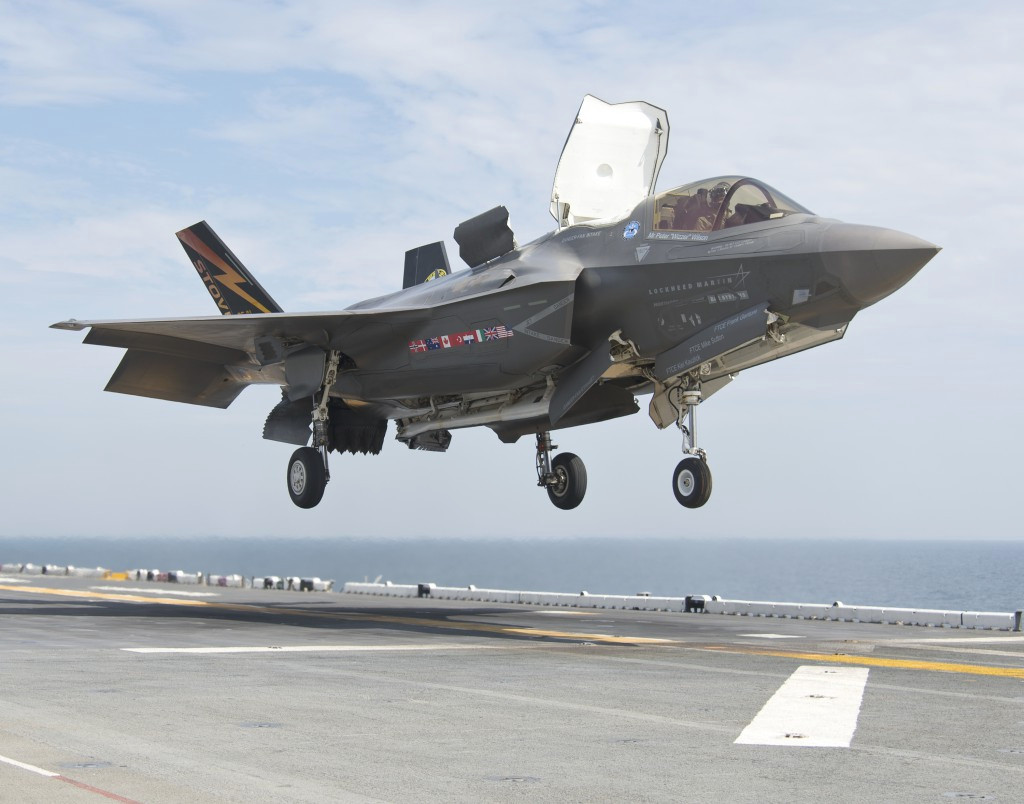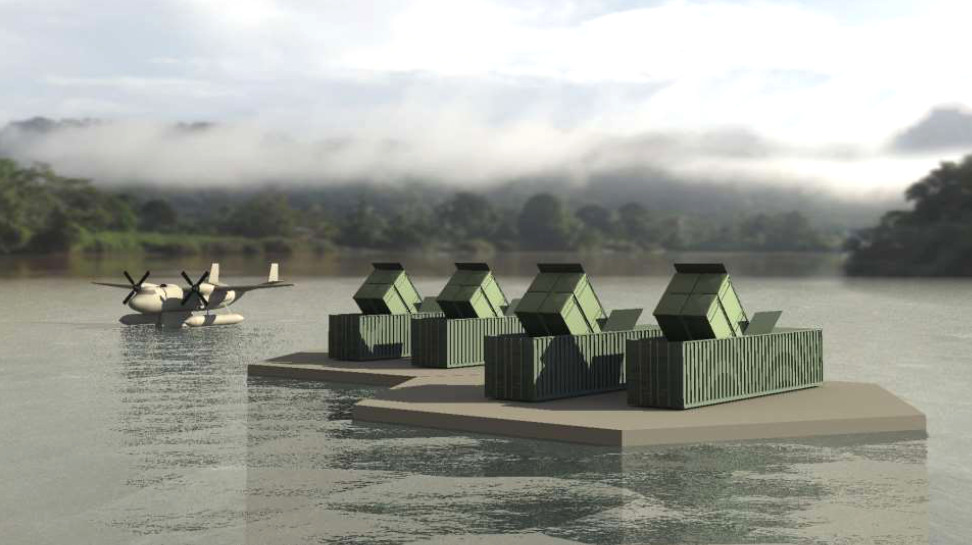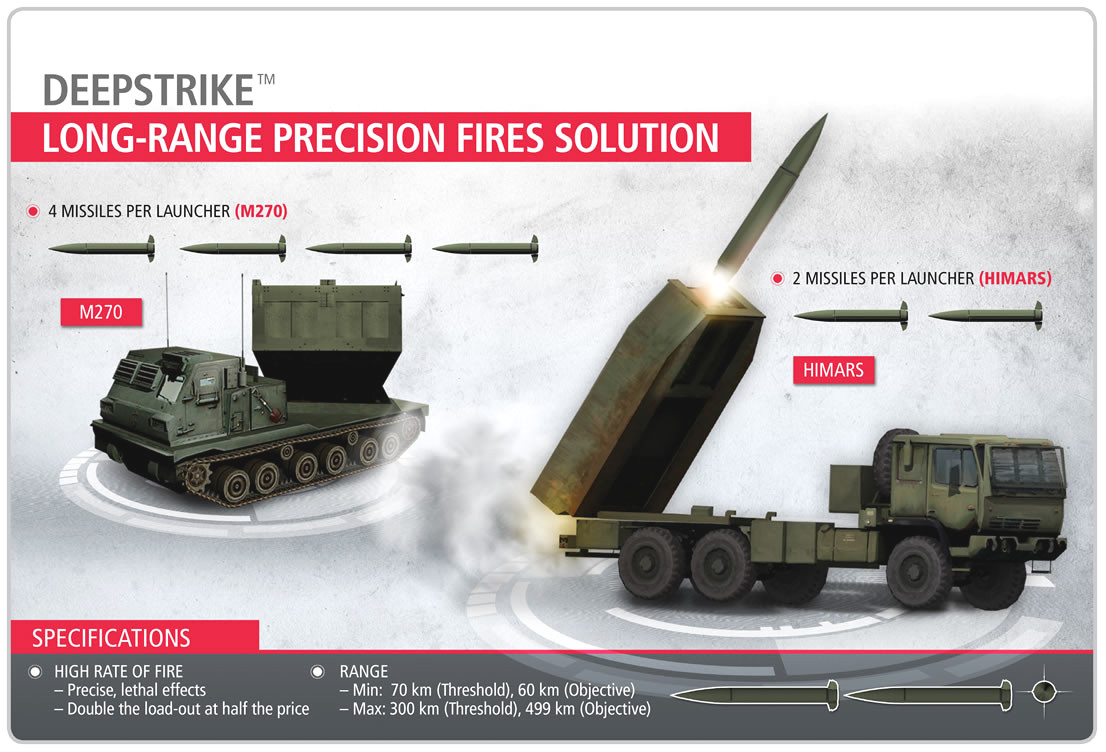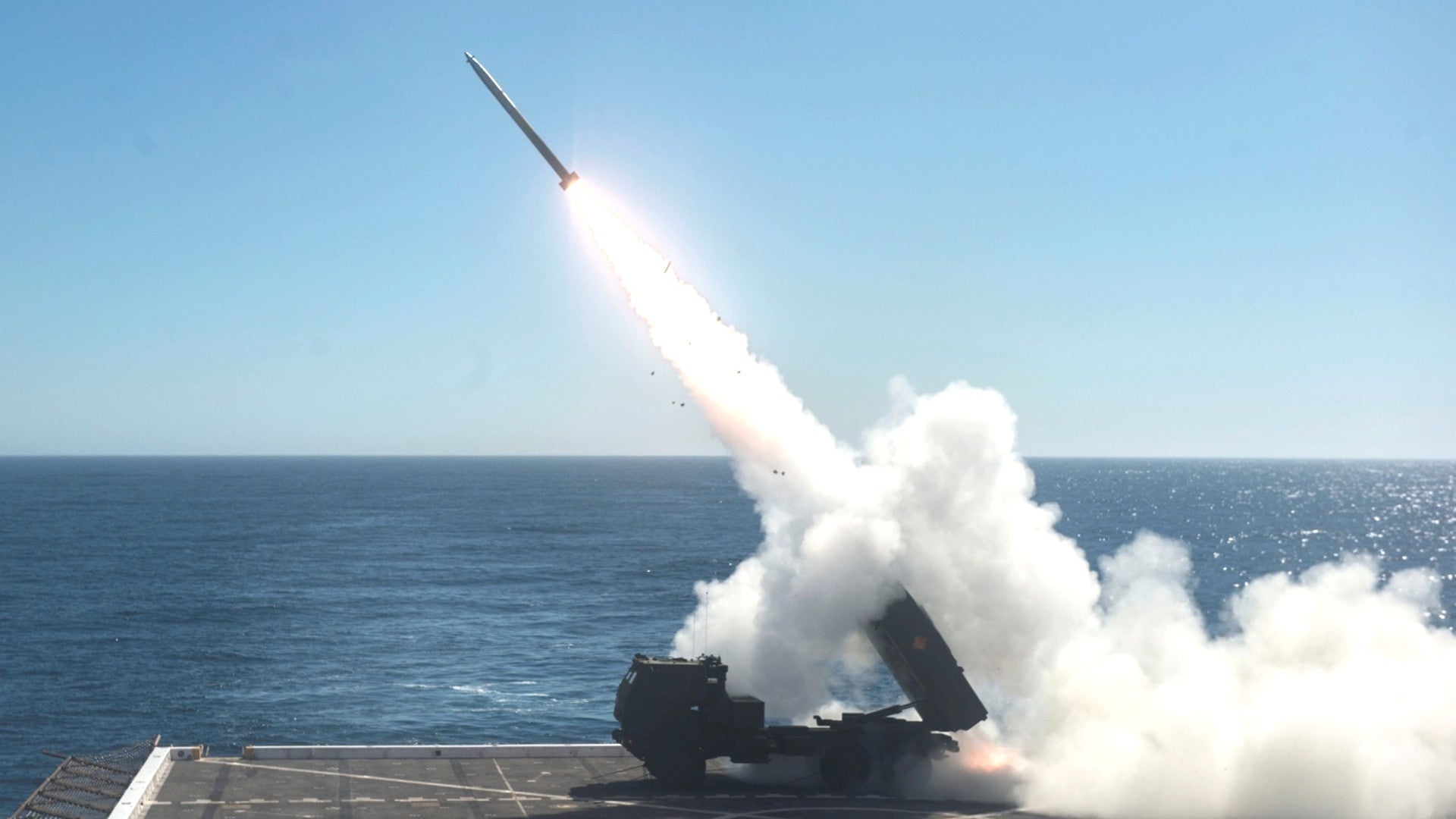As it had long planned, the U.S. Marine Corps has successfully fired a 227mm GPS-guided rocket from the flight deck of a ship during an annual exercise in the Pacific region, nicknamed Dawn Blitz 2017. Something we at The War Zone have highlighted
many times in the past, this combination could offer an important new capability for traditional amphibious operations, more limited contingencies, and even possibly operations further out at sea.
Marines of the 5th Marine Battalion, 11th Marine Regiment conducted the mock fire support mission with a truck-mounted M142 High Mobility Artillery Rocket System (HIMARS) while on board the USS Anchorage, a San Antonio-class landing platform dock. The 227mm M31 Guided Multiple Launch Rocket System (GLMRS) round hit a target floating in the Pacific Ocean with its 200 pound high explosive warhead approximately 43 miles away, the maximum range of the weapon.
“We had two training objectives for today’s shoot,” U.S. Army Major Adam Ropelewski, the lead planner attached to I Marine Expeditionary Force for what the exercise organizers termed “sea-based expeditionary fires,” explained. “The first training objective was demonstrating this capability and, second, we wanted to have good effects on the target. We achieved both objectives.”
Dawn Blitz, as a whole, is an annual amphibious warfare drill that runs Marines, sailors, and other U.S. military forces through scenarios based on potential global emergencies. Prepositioned Marine expeditionary units embarked on Navy amphibious ships remain one of America’s primary means of quickly responding to a crisis of any kind, including natural disasters.

For the 2017 iteration of the exercise, Marines from the I Marine Expeditionary Force have joined forces with the Anchorage, as well as the amphibious assault ship USS Essex, the landing ship dock USS Rushmore, and the Arleigh Burke-class destroyer USS Wayne E. Meyer, as well as small patrol boats from Coastal Riverine Group One. Members of the U.S. Army are also involved or otherwise present to observe, as are foreign allies. Most notably, an infantry company from Japan’s Ground Self-Defense Force its taking part in the drill.
“Dawn Blitz 2017 is an excellent opportunity to operationalize concepts the Navy and Marine Corps services have been discussing for some time,” Navy Commander Matthew Hoekstra, the lead exercise planner, said. “While others continue to talk, wargame or tabletop future concepts, we are executing with live forces afloat and ashore.”
The sea-based HIMARS launch was one of a number of firsts for the event. This is also the first year that the Marine Corps’ F-35B Joint Strike Fighters have joined the exercise.

But Marines using of artillery rockets and other weapons while still on board a ship is definitely something that the service has been considering for some time. Since taking up the post of Commandant in 2015, U.S. Marine Corps General Robert Neller has been vocal about challenging established notions about the way his troops operate.
“You’re not going to see Marines just sitting down on their bunks reading magazines,” Neller said at the Marine Corps League’s annual Modern Day Marine exposition in September 2017. “You’re going to see snipers up on the weather deck. You’re going to see guys up there with Javelins and heavy guns. You’re going to see air defenders up there with air defense systems.”
HIMARS, in particular, makes a lot of sense for sea-based operations. The wheeled launcher can either hold six 227mm rockets or a single, larger short-range ballistic missile, known as the Army Tactical Missile System (ATACMS) inside a standardized rocket pod that makes the whole system relatively easy to reload. With that latter weapon, crews can hit targets approximately 190 miles away.

It’s already been a major factor in the U.S.-led campaign against ISIS in Iraq
and Syria, where the weapons offered an alternative to air strikes to launch precision strikes against terrorist emplacements. Unlike fixed wing combat aircraft or gunship helicopters, HIMARS doesn’t get grounded due to sandstorms or low overcast skies.
Depending on whether or not there are already aircraft on station, artillery, including the guided rockets, responds to requests for support much faster. These benefits had already made it a weapon of choice in Afghanistan, including for targeted strikes against particular militants.
With these weapons on amphibious ships sitting off shore, Marines would be able to have on-call, precision artillery fire during an amphibious landing without having the launchers at increased risk on the beachhead itself or relying mainly on aircraft or attack helicopters for this type of support. Once the initial landing area is secure, the trucks can go ashore and continue to support the force as it moves further inland, complimenting air support carriers and amphibious assault ships.
“We know we can shoot HIMARS [High Mobility Artillery Rocket System] off the flight deck of a ship,” Neller added at the Modern Day Marine exposition. “You’re going to see precision fire delivered off amphib ships, whether it comes out of tube guns or rockets or delivered from unmanned systems.”

Even the basic 227mm GPS-directed rockets would give amphibious ships significantly more stand-off capability than they have at present. The design for the San Antonio-class included space for two Mk 41 eight-cell vertical launch system (VLS), but the ships did not reach the fleet with those weapons in place. Whidbey Island-class landing ship docks and Wasp– and America-class amphibious assault ships do not have any such provisions at all.
In December 2016, Neller had brought up the possibility of adding the VLS cells onto the San Antonio’s in order to let them carry Tomahawk land attack cruise missiles. He pointed to a series of attacks off the coast of Yemen that year in which Iranian-backed Houthi rebels had fired anti-ship missiles at American naval vessels, including the San Antonio herself. The amphibious ship lacked the means to retaliate directly.
However, the original plan had been to pack the San Antonio’s VLS full of RIM-162 Evolved Sea Sparrow Missiles (ESSM), four of which can fit in each cell, in order to expand the air defense capabilities of an amphibious expeditionary strike group. Each cell could only have accommodated a single Tomahawk. The War Zone’s own Tyler Rogoway has previously argued that adding the VLS capability in would be a major boon to the ships and also noted that it might even make more sense to just use that space for fixed GMLRS rocket pods to begin with, something that would make sense on other surface ships, too.
With HIMARS launchers on the deck, the ship would have had another, potentially more flexible means to respond to multiple threats. A Marine artillery crew would be able to reload much faster than sailors would be able to insert new missiles into the VLS for follow up with additional strikes if more targets presented themselves, as well. The Marine Corps is also looking at a concept that would move the rocket launcher into a containerized package, dubbed “Box O’Rockets,” that would be easy to mount on standard cargo trucks or any appropriate flat surface on a ship or on land.

This capability would give amphibious ships more options during more limited contingencies where Marines might not even conduct sustained operations ashore. In 2016, Marines supported local Libyan forces in the city of Sirte as they fought to eject members of an ISIS-aligned terrorist group who had seized control.
The Marine expeditionary unit flew strikes using its AV-8B Harrier jump jets and AH-1W Super Cobra attack helicopters. With no direct threat to the amphibious ships off shore acting as sea bases for the operation, it would have been just as easy for them to move within HIMARS range. Though it would’ve been limited to hitting fixed targets, a launcher on the flight deck would have been able to hit anywhere within the city just with GMLRS rockets from well within international waters. The addition of dual-mode kit with a laser guidance option could solve the moving target problem, with fixed-wing aircraft, drones, gunships, or troops on the ground with the appropriate equipment actually putting the laser beam on the target.
Combined with the Navy’s new massive floating sea bases, Marines in the future might easily be able to part themselves off the coast of crisis zone and conduct precision strikes against terrorists and militants from a safe, stand-off position. Add networked sensors, including information fed back to HIMARS crews from manned and unmanned aircraft, as well as other ships, and their ability to quickly and accurately engage hostiles ashore only expands.
The Navy already has separate plans for an overarching fire-control network to link together all of its planes and ships, known as the Naval Integrated Fire Control-Counter Air (NIFC-CA). The basic idea is to be able to share targeting information rapidly to allow sailors or pilots to engage targets that might be outside the range of their own sensors or otherwise attack targets without having to rely on their own systems.

For HIMARS, this might mean a future where a drone spots a target ashore, translates that information into specific GPS coordinates and sends that directly the launcher crew by way of the amphibious ship. It might even allow for more complex strikes if new, longer range rockets or missiles that employ other attack modes become available for the weapon system.
Specifically, both the Marine Corps and the Army are actively looking at the possibility of using the eminently modular HIMARS to fire anti-ship missiles. A launcher able to fire something such as Lockheed Martin’s Long Range Anti-Ship Missile (LRASM) or the Raytheon-Kongsberg Joint Strike Missile would quickly turn artillery crews into ship killers and amphibious ships in multi-purpose strike platforms.

On top of that, Raytheon is working on a new long-range missile to replace the ATACMS known as DeepStrike. The company says the final product should be able to hit targets approximately 310 miles away, significantly increasing the distance at which HIMARS crews would be able to engage the enemy. Each launcher would be able to hold two DeepStrike missiles instead of just a single ATACMS, too. An extended range version of the standard 227mm rocket, that can travel nearly 60 miles is also in development.

Moreover, in theory, the Marines should have been able to conduct the HIMARS mission from the flight decks on any sufficiently large surface ship, as well as on land, which might allow for additional flexibility. The Navy recently said it was considering reactivating a number of mothballed Oliver Hazard Perry-class frigates, but with virtually no upgrades to their weapons or sensors. The service has similarly struggled to improve the capabilities of the long under-performing two-class Littoral Combat Ship (LCS) family and began developing the requirements for a new guided missile frigate earlier in 2017. Placing one of the launchers on the helipads on any of these ships could immediately make them more versatile in a host of low-risk scenarios.
It seems likely that in the future, Marine and Army artillery crews will even more heavily integrate HIMARS with Navy amphibious ships and Army watercraft, even if just to rapidly reposition them. Especially in the Pacific region, quickly placing the launchers on one small island might allow troops to easily threaten another during a crisis or outright conflict. Vietnam appears to have already done this in the heavily contest South China Sea, deploying its truck-mounted Israeli-made EXTRA artillery rocket systems, similar to the HIMARS system, to islands it controls that are within range of China’s growing constellation of man-made outposts.
Other countries have already seized on the concept of quickly adding long range capabilities to various ships using containerized artillery rockets and missiles in general. Russia has announced plans to install containerized anti-ship missiles on board a new class of ice-breaking corvettes that will patrol the countries arctic territories.

In June 2017, Israel test fired its Long-Range Artillery (LORA) system from a ship and South Korea launched a new version of its Hyunmoo-2 ballistic missile from a truck-mounted launcher on board a floating platform. In the South Korean case, the use of a sea-based test structure was due to the nature of the firing range, but still highlighted a potential maritime application for the system. The ability to rapidly preposition these weapons using various ships would offer additional flexibility during a so-called “decapitation strike” against North Korea or during a broader conflict on the Korean peninsula.
Containerized and otherwise highly mobile fire support systems have become increasingly popular beyond rockets and missiles, too. Finnish firm Patria offers a version of its lightweight, turreted NEMO 120mm breech-loaded mortar that fits inside its own special pod. This turns a regular flatbed cargo truck or any ship able to carry a standard shipping container into a fire support weapon.
With all of these developments in mind, it seems almost certain the Marines and other U.S. military services are only starting to discover the capabilities that a shipboard HIMARS launcher could provide for future operations.
Contact the author: joe@thedrive.com
